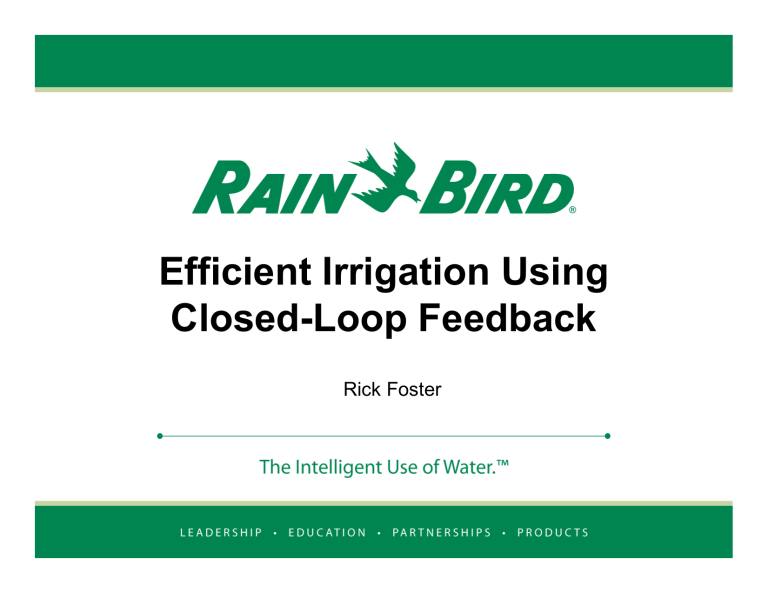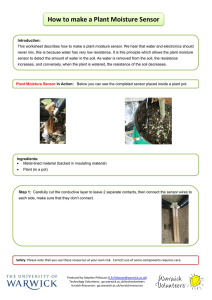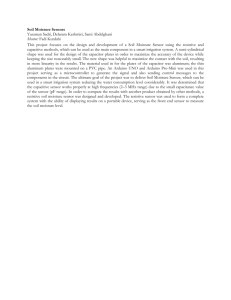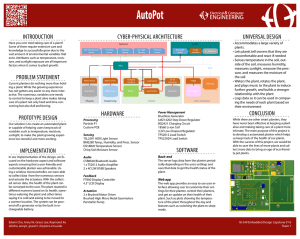Efficient Irrigation Using Closed-Loop Feedback
advertisement

Efficient Irrigation Using Closed-Loop Feedback Rick Foster “When the well’s dry, we know the worth of water.” -Benjamin Franklin 97% of all water is saltwater, 2% is held in snow and icebergs. Only 1% is freshwater. Historically, technology and lifestyle improvements have led to the doubling of water consumption every 20 years. On average, residents in the U.S. use 101 gallons of water per day. If water is used more efficiently, it can have a significant impact on the available supply. The need to use water responsibly has never been greater. Anatomy of Soil Water Content Saturation •Water Run-off •Heavy Nutrient Loss •Root Putrefaction Wasted Water Control Range Gravitational Effects Soil Field Capacity Reservoir Plant Stress Permanent Wilt Point Plant Death Parched Plant Available Water (PAW) Management Allowable Depletion (50% of PAW) Closed Loop Systems Control Theory – Scientific theory focused on influencing the behavior of dynamic systems Open-Loop Control – No direct link between the output of the system and the conditions being controlled Closed-Loop Control – A sensor is deployed to provide feedback – System output is controlled by the feedback signal Open-Loop Control Systems Reference Controller Controller Program System Input Irrigation Water Dynamic System System Output Moisture at the Root Zone Closed-Loop Control Systems Reference Measured Error Controller Measured Output Volumetric Water Content System Input Dynamic System System Output Sensor Moisture at the Root Zone Application to Irrigation Systems Traditional Open Loop: – Root zone soil moisture is controlled without direct measurement/feedback – Plant moisture requirements may be measured by inference from related variables (weather) Closed Loop Feedback: – Root zone soil moisture is controlled by direct measurement and feedback – Precision is dictated by sensor Closed-Loop Feedback System Advantages for Irrigation Measures moisture directly at the root zone No need for seasonal clock adjustments No need for any end-user intervention System automatically adjusts for varying temperatures, precipitation, and other changes in weather which influence soil moisture content Metrics are gathered directly from the site Water savings of 40% or more versus a well programmed standard controller Smart Control with Soil Moisture Sensors IA SWAT recognition and testing Recognized by a growing list of water purveyors Arizona Oregon California Texas Colorado Utah Nevada Washington Single Sensor Feedback Systems Sensor Location Choose a full-sun location Avoid low spots where water typically collects Avoid high spots where drainage may not be representative of the site Avoid locations exposed to heavy foot traffic Avoid location near hard-scapes Avoid locations which are irrigated by more than one zone Single Sensor Closed-Loop Feedback Required Site Data Effective Precipitation Rate for Each Irrigated Zone – Used for tracking non-sensor zones to sensor zone – Program controller accordingly Nothing Else Soil Volumetric Water Content (VWC) Water with ionic contaminants is a WATER = 50% SOIL = 50% conductor AIR = 15% WATER = 35% SOIL = 50% Soil Constituent Permittivity Measurements: – Air: – Soil: – Water: 1 4 80 Soil conductivity and permittivity can be used as a metrics to determine VWC Soil Moisture Sensors Historical Challenges Accuracy – The ability of a sensor to report absolute moisture values Precision – The degree of reproducibility of a sensor’s performance over time Limited Sensor Life/Durability Difficult to install and Set-up Frequent Maintenance Sensor Types Relative Soil Moisture Sensors – Sensor reading changes with moisture content but also changes with other environmental conditions. – Relative sensors require calibration to the specific installation environment. – As the environment changes the readings become unreliable. Absolute Soil Moisture Sensors – Sensor provides a stable moisture reading when soil type, compaction, electrical conductivity, or temperature changes. Moisture Sensor Technologies Soil Electrical Conductivity Soil Permittivity/Dielectric Constant – Capacitance – LC Resonance Electromagnetic Wave Propagation Time – Various formats (TDR, FDR, TDT) – Analog – Digital Measurement Methods Electrical Conductivity (EC) Basis: Conductivity increases with water content (sometimes) Advantage: Low cost Disadvantage: Pure water is an Insulator and has no conductivity. Changes in ion concentration and temperature cause very large errors in this method. Soil Moisture Measurement Methods Permittivity Measurement - Capacitor Basis: Dielectric constant of water is ~30X that of other soil constituents. Advantage: low cost Disadvantages: – EC losses in the soil distort the capacitance readings – Dielectric constant of water is temperature dependent – Capacitive probes are ‘surface’ sensitive and thus subject to large air-gap errors Soil Moisture Measurement Methods Permittivity Measurement – LC Resonance Basis: Dielectric constant of water is ~30X that of other soil constituents. Advantage: Higher frequency operation results in EM wave penetration of the soil, reducing air gap problem. Disadvantages: – EC losses in the soil distort the capacitance readings – Dielectric constant of water is temperature dependent – Capacitive probes are ‘surface’ sensitive and thus subject to large air-gap errors. Soil Moisture Measurement Methods Time Domain Transmissometry + Digital Signal Processing Basis: Measures time for an electric pulse to travel along the sensor’s waveguide Patented technology – Digitizing the waveform at high frequencies – Signal processing required to extract the time delay information Advantages – Inherently stable readings of VWC – Measurements accurate with changing soil type, temperature, and EC Absolute Soil Moisture Measurements SMRT-Y Soil Moisture Sensor Overview Add-on device for all standard controllers Suspends irrigation when soil moisture exceeds a set threshold Bypass feature allows isolation of up to two zones from the influence of the sensor Simple installation and set-up Accurate and stable moisture readings – no calibration required Targeting residential and light commercial applications Makes any controller “Smart” SMRT-Y Soil Moisture Sensor How it works….Dry Conditions SMRT-Y Soil Moisture Sensor How it works….Wet Conditions Simplified Sensor Installation 1) Select a full sun location for the sensor 2) Install the sensor 3 to 5 in. below the surface 3) Connect the sensor to the nearest valve Sensor Wiring Detail Any Zone Wire Splice Identify multiple sensor locations Choose a sensor location near a valve box Connect the sensor to an existing zone wire User Interface Wiring Detail Controller Connect the 24V and Common Identify the “Sensor Zone” Disconnect the zone wire and connect to Red Disconnect the field common and connect to White Connect the Green wire to the “Sensor Zone” Blue and Brown zone bypass wires are optional Field Common “Sensor Zone” wire Simplified Moisture Threshold Programming SMRT-Y Auto Set Features 1) Saturate the sensor area 2) Set any zone on the controller to water the next morning 3) Initiate the auto-set feature The controller will automatically set the moisture threshold to 80% of field capacity when the controller initiates irrigation. Threshold can be manually set and adjusted up or down depending on the site requirements. Worry-Free Irrigation with Closed Loop Irrigation and Soil Moisture Sensors







